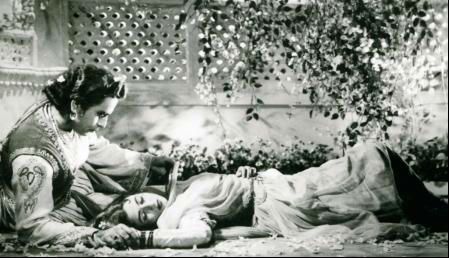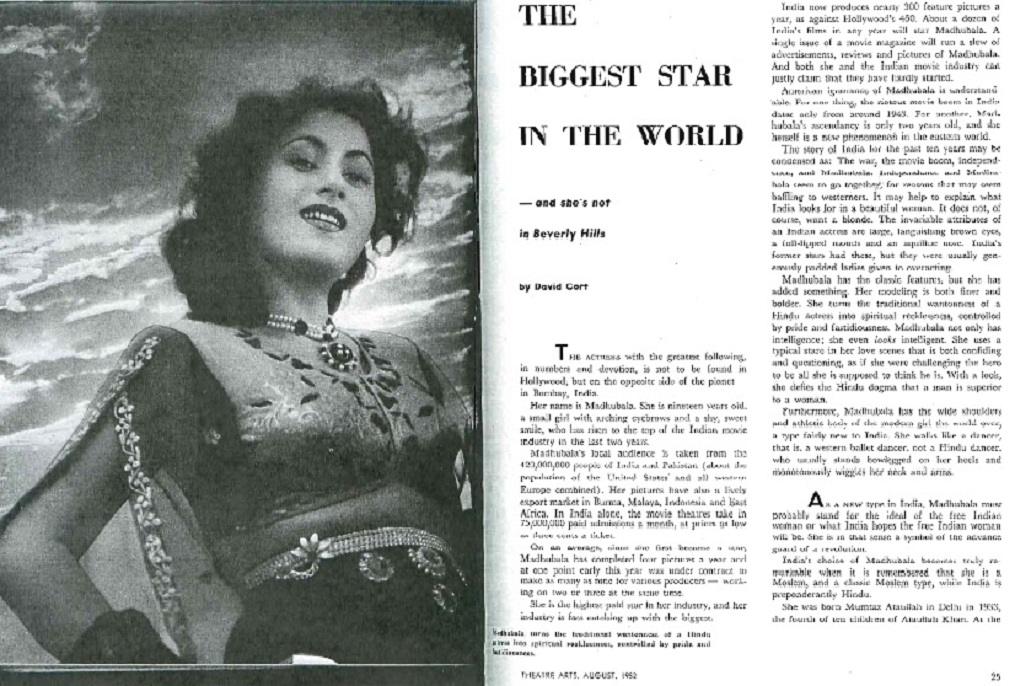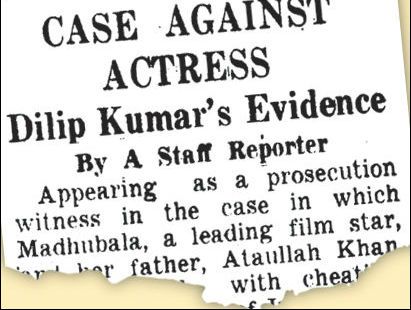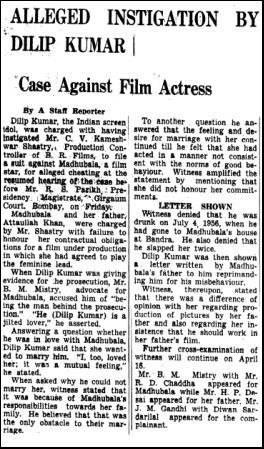Madhubala, actress
(→Hollywood desires Madhubala) |
(→Biography) |
||
| Line 9: | Line 9: | ||
=Biography= | =Biography= | ||
| + | =='' The Biggest Star in the World – and she’s not in Beverly Hills '' == | ||
| + | |||
| + | David Cort, LIFE magazine, August, 1952 | ||
| + | |||
| + | |||
| + | The actress with the greatest following, in numbers and devotion, is not to be found in Hollywood, but on the opposite side of the planet — in Bombay, India. | ||
| + | |||
| + | Her name is Madhubala. She is nineteen years old, a small girl with arching eyebrows and a shy, sweet smile, who has risen to the top of the Indian movie industry in the last two years. | ||
| + | |||
| + | Madhubala’s local audience is taken from the 420,000,000 people of India and Pakistan (about the population of the United States and all western Europe combined). Her pictures have also a lively export market in Burma, Malaya, Indonesia and East Africa. In India alone, the movie theatres take in 75,000,000 paid admissions a month, at prices as low as three cents a ticket. | ||
| + | |||
| + | On an average, since she first became a star, Madhubala has completed four pictures a year and at one point early this year was under contract to make as many as nine for various producers — working on two or three at the same time. | ||
| + | |||
| + | She is the highest paid star in her industry, and her industry is fast catching up with the biggest. | ||
| + | |||
| + | India now produces nearly 300 feature pictures a year, as against Hollywood’s 450. About a dozen of India’s films in any year will star Madhubala. A single issue of a movie magazine will run a slew of advertisements, reviews and pictures of Madhubala. And both she and the Indian movie industry can justly claim that they have hardly started. | ||
| + | |||
| + | American ignorance of Madhubala is understandable. For one thing, the riotous movie boom in India dates only from around 1943. For another, Madhubala’s ascendancy is only two years old, and she herself is a new phenomenon in the eastern world. | ||
| + | |||
| + | The story of India for the past ten years may be condensed as: The war, the movie boom, independence, and Madhubala. Independence and Madhubala seem to go together, for reasons that may seem baffling to westerners. It may help to explain what India looks for in a beautiful woman. It does not, of course, want a blonde. The invariable attributes of an Indian actress are large, languishing brown eyes, a full-lipped mouth and an aquiline nose. India’s former stars had these, but they were usually generously padded ladies given to overacting. | ||
| + | |||
| + | Madhubala has the classic features, but she has added something. Her modeling is both finer and bolder. She turns the traditional wantonness of a Hindu actress into spiritual recklessness, controlled by pride and fastidiousness. Madhubala not only has intelligence; she even looks intelligent. She uses a typical stare in her love scenes that is both confiding and questioning, as if she were challenging the hero to be all she is supposed to think he is. With a look, she defies the Hindu dogma that a man is superior to a woman. | ||
| + | |||
| + | Furthermore, Madhubala has the wide shoulders and athletic body of the modern girl the world over, a type fairly new to India. She walks like a dancer, that is, a western ballet dancer, not a Hindu dancer, who usually stands bowlegged on her heels and monotonously wiggles her neck and arms. | ||
| + | |||
| + | AS A NEW type in India, Madhubala must probably stand for the ideal of the free Indian woman or what India hopes the free Indian woman will be. She is in that sense a symbol of the advance guard of a revolution. | ||
| + | |||
| + | madhu-badal | ||
| + | |||
| + | India’s choice of Madhubala becomes truly remarkable when it is remembered that she is a Moslem, and a classic Moslem type, while India is preponderantly Hindu. | ||
| + | |||
| + | She was born Mumtaz Ataullah in Delhi in 1933, the fourth of ten children of Ataullah Khan, At the age of six, she was spotted by a movie producer, given the name of Madhubala and a small part; at a wage of $45 a month. This prospect of added income induced her father, when she was nine, to move his family to Bombay, the center of India’s movie industry. | ||
| + | |||
| + | An atmosphere of sheer nightmare quickly closed in on the family. Almost immediately the dock explosion and fire of April 14, 1944, (a historic date in India) wiped out their home and possessions. Appropriately, the family escaped death or injury because they had been to the movies, at a theater distant from the scene of the disaster. | ||
| + | |||
| + | In 1947 came the tragic communal disorders, during which the Hindus drove 6,000,000 Moslems out of India, massacring half a million and abducting thousands of women. Madhubala and her sisters knew they were among the hunted. But by this time she had acted in five pictures for Ranjit Movietone, in the last one as a star, and her position probably saved the family. | ||
| + | |||
| + | It is a measure of India’s ability to grow in tolerance that, as it became more used to freedom, it reversed itself and chose to love the Moslem Madhubala. However, anti-Moslem prejudice must continue to be one of her chief problems. She is the victim of a whispering campaign that accuses her, for example, of eating the meat of the cow, which is sacred to Hindus. To offset such rumors she gave her life savings of 50,000 rupees to the Bengal Refugee Fund last winter to help Hindu refugees from Moslem East Pakistan. Her friends said that this proved her “a real daughter of Mother India.” Her enemies turned the gift against other Moslem stars: “Why not also Dilip Kumar, Nargis, Suraiya, Yaqub? Or are they hoarding money to be sent to Pakistan?” | ||
| + | |||
| + | Madhubala’s private life is in marked contrast to the roles she plays in the movies. Most often, though not invariably, she takes the part of a bad girl. The typical Indian plot casts her as a rich and frivolous heiress pursuing a poor but noble youth. India is more and more freely borrowing themes from such Western plays as Smilin’ Through and Pygmalion. | ||
| + | |||
| + | Madhubala has a delicately sensuous figure. The movie magazines have called her “the Venus of the screen.” The advertisements for one picture sarcastically show her cowering under the waving hoofs of a rearing stallion. It should be added, however, that a kiss or any extensive exposure of the female person is never permitted in an Indian movie. | ||
| + | |||
| + | The biggest star in the world has one final perfection in her name. The “bala” part is only a feminine ending, but “Madhu” means variously “fragrant,” “spring,” and “love.” It seems curiously right that free India should have chosen to worship an actress named “fragrant spring of love.” | ||
| + | ==Subhash K. Jha's biography== | ||
''' Magical Madhubala ''' | ''' Magical Madhubala ''' | ||
Revision as of 15:22, 16 October 2016

This is a collection of articles selected for the excellence of their content.
|
Contents |
Biography
The Biggest Star in the World – and she’s not in Beverly Hills
David Cort, LIFE magazine, August, 1952
The actress with the greatest following, in numbers and devotion, is not to be found in Hollywood, but on the opposite side of the planet — in Bombay, India.
Her name is Madhubala. She is nineteen years old, a small girl with arching eyebrows and a shy, sweet smile, who has risen to the top of the Indian movie industry in the last two years.
Madhubala’s local audience is taken from the 420,000,000 people of India and Pakistan (about the population of the United States and all western Europe combined). Her pictures have also a lively export market in Burma, Malaya, Indonesia and East Africa. In India alone, the movie theatres take in 75,000,000 paid admissions a month, at prices as low as three cents a ticket.
On an average, since she first became a star, Madhubala has completed four pictures a year and at one point early this year was under contract to make as many as nine for various producers — working on two or three at the same time.
She is the highest paid star in her industry, and her industry is fast catching up with the biggest.
India now produces nearly 300 feature pictures a year, as against Hollywood’s 450. About a dozen of India’s films in any year will star Madhubala. A single issue of a movie magazine will run a slew of advertisements, reviews and pictures of Madhubala. And both she and the Indian movie industry can justly claim that they have hardly started.
American ignorance of Madhubala is understandable. For one thing, the riotous movie boom in India dates only from around 1943. For another, Madhubala’s ascendancy is only two years old, and she herself is a new phenomenon in the eastern world.
The story of India for the past ten years may be condensed as: The war, the movie boom, independence, and Madhubala. Independence and Madhubala seem to go together, for reasons that may seem baffling to westerners. It may help to explain what India looks for in a beautiful woman. It does not, of course, want a blonde. The invariable attributes of an Indian actress are large, languishing brown eyes, a full-lipped mouth and an aquiline nose. India’s former stars had these, but they were usually generously padded ladies given to overacting.
Madhubala has the classic features, but she has added something. Her modeling is both finer and bolder. She turns the traditional wantonness of a Hindu actress into spiritual recklessness, controlled by pride and fastidiousness. Madhubala not only has intelligence; she even looks intelligent. She uses a typical stare in her love scenes that is both confiding and questioning, as if she were challenging the hero to be all she is supposed to think he is. With a look, she defies the Hindu dogma that a man is superior to a woman.
Furthermore, Madhubala has the wide shoulders and athletic body of the modern girl the world over, a type fairly new to India. She walks like a dancer, that is, a western ballet dancer, not a Hindu dancer, who usually stands bowlegged on her heels and monotonously wiggles her neck and arms.
AS A NEW type in India, Madhubala must probably stand for the ideal of the free Indian woman or what India hopes the free Indian woman will be. She is in that sense a symbol of the advance guard of a revolution.
madhu-badal
India’s choice of Madhubala becomes truly remarkable when it is remembered that she is a Moslem, and a classic Moslem type, while India is preponderantly Hindu.
She was born Mumtaz Ataullah in Delhi in 1933, the fourth of ten children of Ataullah Khan, At the age of six, she was spotted by a movie producer, given the name of Madhubala and a small part; at a wage of $45 a month. This prospect of added income induced her father, when she was nine, to move his family to Bombay, the center of India’s movie industry.
An atmosphere of sheer nightmare quickly closed in on the family. Almost immediately the dock explosion and fire of April 14, 1944, (a historic date in India) wiped out their home and possessions. Appropriately, the family escaped death or injury because they had been to the movies, at a theater distant from the scene of the disaster.
In 1947 came the tragic communal disorders, during which the Hindus drove 6,000,000 Moslems out of India, massacring half a million and abducting thousands of women. Madhubala and her sisters knew they were among the hunted. But by this time she had acted in five pictures for Ranjit Movietone, in the last one as a star, and her position probably saved the family.
It is a measure of India’s ability to grow in tolerance that, as it became more used to freedom, it reversed itself and chose to love the Moslem Madhubala. However, anti-Moslem prejudice must continue to be one of her chief problems. She is the victim of a whispering campaign that accuses her, for example, of eating the meat of the cow, which is sacred to Hindus. To offset such rumors she gave her life savings of 50,000 rupees to the Bengal Refugee Fund last winter to help Hindu refugees from Moslem East Pakistan. Her friends said that this proved her “a real daughter of Mother India.” Her enemies turned the gift against other Moslem stars: “Why not also Dilip Kumar, Nargis, Suraiya, Yaqub? Or are they hoarding money to be sent to Pakistan?”
Madhubala’s private life is in marked contrast to the roles she plays in the movies. Most often, though not invariably, she takes the part of a bad girl. The typical Indian plot casts her as a rich and frivolous heiress pursuing a poor but noble youth. India is more and more freely borrowing themes from such Western plays as Smilin’ Through and Pygmalion.
Madhubala has a delicately sensuous figure. The movie magazines have called her “the Venus of the screen.” The advertisements for one picture sarcastically show her cowering under the waving hoofs of a rearing stallion. It should be added, however, that a kiss or any extensive exposure of the female person is never permitted in an Indian movie.
The biggest star in the world has one final perfection in her name. The “bala” part is only a feminine ending, but “Madhu” means variously “fragrant,” “spring,” and “love.” It seems curiously right that free India should have chosen to worship an actress named “fragrant spring of love.”
Subhash K. Jha's biography
Magical Madhubala
By Subhash K. Jha or LMN or both Sentinel Assam
The name itself invokes so many enigmas, that it’s just overwhelming! Venus of the east, the most beautiful woman to adorn the Hindi film screen, Madhubala represents the era of beauty, romance and sometimes tragedy associated with Hindi films.
Born Mumtaz Jehan Begum Dehelvi in a poor Pathan Muslim family in 1933, she made her debut as a child artiste in the early 40’s, she never looked back and though huge success eluded her for a while, it was Mahal which released in 1949 that made her a star forever.
Madhubala was 17 when she became a star and her aura in the film Mahal has spell binding capability. Ayega Aanewal she sung on screen, and froze one of the most glorifying moments of Hindi film history, a moment portraying timelessness of beauty in the purest form.
Her beauty had child like quality, fragile yet confident. Her luminous eyes, her royal gait and that bewitching smile makes her the best poster picture one can imagine. For years I have noticed most beauty parlours adorning her on their walls as if endorsing their beauty business by the symbol of beauty itself. Madhubala was actress par excellence too, only she was not credited initially when her films flopped in the 50s (Tarana, Sangdil and Amar) could not meet box office success and she was labelled a jinx. Later, she however bounced back with a row of hit and memorable films culminating finally into the biggest film of Hindi cinema Mughal-E-Azam that truly made her a legend for her talent and not just beauty.
It’s often when a woman is too beautiful, her beauty distracts from her performances. Whenever I watch a Madhubala film I’m spellbound by her beauty so much that it’s hard to notice her great performance. In Guru Dutt’s Mr.& Mrs.55 there is this scene when some street kids find her near Guru Dutt’s apartment (she is a rich woman dressed well), and mistake her to be a ‘fairy’, they do not want to come near fearing that the ‘fairy’ may disappear. This particular scene truly describes her persona. She was so very beautiful that she seemed surreal and one would be so stunned to see her that going near her other aspects was difficult. Such was the effect.
She is well remembered for her role in Howrah Bridge where she played a seductress and the song Aayiye Meharbaan is perhaps amongst her most enchanting one’s.
Madubala had brilliant comic timing and could easily match pace with Kishore Kumar too. Her role in Mr & Mrs 55 also showcased her comic talent, so did Half Ticket and Chalti Ka Naam Gaadi.
Madubala was sadly diagnosed to have a heart condition at the peak of her career and she sadly could not continue to work. Also she went through heartbreak when her romantic relationship with Dilip Kumar could not culminate in a marriage. Dilip Ji and Madhubala will always remain a dream pair on Indian Screen, their chemistry was just too perfect, they just lighted up in each other’s presence and it’s so evident on screen. The feather sequence in Mughal-E-Azam will remain one of the most romantic moments of Hindi film history and Pyar Kiya To Darna Kya one of the best known dance sequence. She brought Anarkali alive in the most beautiful manner and immortalized her forever in our minds and hearts.
She was known to be a through professional, punctual, with no starry airs she was known to have a child like demeanour and loved playing pranks and spreading smiles around her. Despite her heart condition she quietly let herself be chained with heavy iron ones for a sequence in Mughal-E-Azam, feeding in to her perfectionist director without complaining, though she was in great pain.
It is said she really wanted to have a happy family and made an attempt at it by marrying Kishore Kumar who converted to Islam to marry her, but the cruel hands of fate were already grabbing her. She did undergo a Cardio Thorasic surgery, but it was to no avail. The Venus was ready to immortalise herself in her death too which came far too prematurely at the age of 36 in 1969. The world lost her to enigma, to the mystery of fate and it’s cruel hands grabbing the most beautiful woman in the prime of her youth.
But Madhubala has already etched herself in our hearts will always remain there forever. (LMN)
Hollywood desires Madhubala
In 1951, celebrity photographer James Burke came to India to shoot a mesmerising session with Madhubala for Life magazine. Theatre Arts magazine in the August 1952 issue, featured her as, “The Biggest Star in the World - and she’s not in Beverly Hills”. Hollywood biggies clamoured to cast her. Filmmaker Frank Capra, besotted by her beauty, tried to cast her when he visited Mumbai for a film festival. But allegedly her father Attaullah Khan refused all the offers. (Filmfare )
With Dilip Kumar
Naya Daur imbroglio
BR Chopra surprised everyone, including his leading lady Madhubala, when he sued her for reneging the contract for Naya Daur (1957). Her father Ataullah Khan had objected to her going for an extended outdoor shoot with Dilip Kumar. And while Dilip Kumar witnessed against Ataullah Khan, he also ended up confessing his love for Madhubala in the courtroom. The news made banner headlines… but ended their relationship.
Legal wrangles
The best-known case of a famous actress losing her good name in the wake of a much publicized court case is Madhubala, screen goddess of the 1950s. Producer-director B R Chopra filed a case against Madhubala and her father Ataullah Khan, early into the making of his Naya Daur (1957) for cheating — for taking cash advance on the film and then refusing to honour her contract. The film's hero Dilip Kumar testified in court against Madhubala making for courtroom drama
Instigation by Dilip Kumar? (March 30 | 1957)
From TOI archives (March 29 | 1957)
Dilip Kumar said he had found it "hard to digest" when he heard from the producers of the film in which he was given a role opposite Madhubala that they had to pay Madhubala a sum of Rs 32000 "under duress". He said that he repeatedly told her, that what they had done was wrong...
Dilip Kumar, the Indian screen idol, was charged with having instigated ... B R Films, to file a suit against Madhubala, a film star, for alleged cheating at the resumed hearing of the case ... Presidency magistrate, Girgaum Court...
Madhubala and her father Attaullah Khan, were charged with failure to honour contractual obligation for a film in which she had agreed to play the feminine lead. Mr B M Mistry, advocate for Madhubala, accused him of being the man "behind the prosecuion". "He (Dilip Kumar) is a jilted lover," he asserted. Answering a question whether he was in love with Madhubala, Dilip Kumar said she wanted to marry him. "I too loved her; it was a mutual feeling," he stated. When asked why he could not marry her, witness stated that it was because of Madhubala's responsibilities towards her father. He believed that was the only obstacle to their marriage.
To another question he answered that the feeling and desire for marriage with her continued till he had felt that she had acted in a manner not consistent with the norms of good behaviour...Witness denied that he was drunk on July 4, 1956 when he had gone to Madhubala's house in Bandra....
See also
Madhubala, actress


